RAJA YOGA MEDITATION: THE THEORY AND PRACTICE
By Rev. Fr. Thomas Vempala CMI
MEDITATION IN THE INDIAN TRADITION
Meditation generally means the process of concentrating the attention of one’s mind exclusively on something, usually on some spiritual or religious reality, in order to achieve mental peace and tranquility. The credit of developing meditation as a systematic means of attaining realization of the oneness of the individual soul (jeevatma) and the Absolute Soul (Paramatma) goes to the Rishis (yogis) of ancient India, especially to the sage Patanjali, who systematically codified the theory and practice of Yoga in a treatise called Yoga Sutras around the 5th century B.C.
In the Hindu religious and philosophic tradition, the yogic meditation has been an effective means for the spiritual uplift of man; it is expected to liberate him from earthly bondages and ultimately unite him with the Absolute Soul. In other religions as well, meditation is a higher form of prayer to commune with the divine. But for Hinduism, true to the writings of the Seers, meditation is the definitive method of discovering or realizing the Absolute in one’s own self. The Rishis developed a system of the holistic theory of the relationship between the individual self and the Universal Self, especially during the period of the Aranyakas and Upanishads. Patanjali’s Yoga Sutras give the systematic codification of the theory and practice of meditation based on the authentic Vedic traditions.
A brief survey of the Vedic traditions of ancient India may be useful to describe how a systematic theory and practice of meditation was developed by the ancient sages as part of their quest for the unity of being. The four Vedas, Rig Veda, Sama Veda, Yajur Veda and Adharva Veda are the most sacred scriptures of Hinduism. The Vedas are called sruti, because they contain authentic knowledge heard by or revealed to the seers (Rishis). They deal withthe religious traditions, prayers to the deities for health, protection, wealth, etc., and rituals for agricultural rites and sacrificial offerings. The word Veda means knowledge. The perceptions of the Rishis in those prayers and rituals regarding the world, God, man, truth, reality, etc., had always been considered as revealed knowledge with unchallenged authority in dealing with the issues in the concerned area of Hindu philosophy and theology.
In the subsequent periods, the Vedas were interpreted differently to suit the special interests of the particular social groups. The priestly caste interpreted the Vedas as a set of rituals in their commentaries called Brahmanas, leaving out its intellectual content. But the ascetically oriented sages, dissatisfied with the ritualism and the exploitation by the priestly clan, retired to the forests to study the Vedas and came up with a divergent commentary of the Vedas, emphasizing the need for a more intellectual and philosophical discussion on the Vedas.
The writings of these ascetics are called Aranyakas (forest texts). The Aranyakas showed that knowledge, wisdom, truth and dharma (duties of life) are more important for a better life than sacrifice and rituals according to the Vedas. The Upanishads carried on this trend of the Aranyakas and further developed the approach to life, truth, knowledge and happiness to a mystical level. They developed consistent theories of the universe (cosmology), of reality (ontology) of knowledge (epistemology) and of the human mind (psychology), reinforcing these theories using the authority of the Vedas. The holistic nature of reality and consciousness and the need of meditation for reaching the realization of the identity of atman and Brahman are central themes of the Upanishads. They also provided the framework for the six major philosophic systems of India, which provided the rational basis for a Yoga system of meditation. The aspirations of the Vedic Rishis echoed in the oldest of Upanishads, Brahadaranyaka Upanishad:
“From the unreal lead me to the real
From darkness lead me to light
From death lead me to immortality “ (1: 3: 28)
This was the basic quest of a man faced with the reality of the world. The Sankya-Yoga-Vedanta philosophic systems developed the theory and practice of meditation based on Vedas and Upanishads and made it as the effective method of answering this basic quest or aspiration of the Rishis. Meditation has been presented as a self empowerment that would enable one to get the awareness of the holistic nature of Reality, namely, the oneness of the reality of the universe and individual self with Brahman, who is the self illuminating immortal Reality. The Yoga Sutras of the sage Patanjali systematically codified the theory and practice of the process of meditation as an effective means of attaining higher consciousness.
The philosophic infrastructure of Patanjali’s Yoga Sutras
Two of the six major philosophic systems, Sankya and Yoga contain all the basic concepts and theories about reality, truth, knowledge and mind on which the theory and practice of meditation are based. Sankya Karika, written by Kapila (8th Cent. AD), is the philosophic foundation of yogic meditation as described in Patanjali’s Yoga Sutras. The Vedanta monistic concept of Brahman (the Absolute) is not found in the Sankya or in the Patanjali Sutras, although the exponents of Vedanta have accepted the yoga system for the attainment of self realization.The ultimate nature of reality for Sankya is dualistic, consisting of two absolutes, Purusha and Prakriti. Purusha is the eternal, all-knowing and absolute Reality without any attributes. Prakriti also is absolute and eternal reality, but it is non sentient. Prakriti is endowed with three elements/attributes (gunas), namely, sattva (luminous -light), rajas (active -energy) and tamas (inactive - darkness). According to Sankya, there are an infinite number of purushas, each of which is existent, eternal and sentient. When Purusha comes into contact with Prakriti, Purusha throws its reflection on Prakriti and the power of Purusha (Maya) infuses Prakriti, disturbing the equilibrium of its three gunas. The three gunas (elements) of Prakriti, when agitated by Maya, which is the power of Purusha, enter into different permutations and combinations
making the unmanifest Prakriti undergo an evolution into different manifest forms. In this process Purusha remains an unattached viewer of these changes, while Prakriti becomes the insentient doer and enjoyer of the changes.
The activities of the gunas, under Maya, make Prakriti, the unmanifest primal source of energy, evolve into the multifarious forms of the visible material universe. The sequence of the process of 24 evolutes is given in Sankya. These 24 evolutes along with Purusha are the 25 principles of the creation of the universe according to Sankya. In this process of evolution, the individual-self (jeevatma) gets bonded to the manifest world by ignorance (avidya). Hence the involvement of the individual self in the evolutionary process of Prakriti and its consequent bonding with the manifest world through Maya
is something that a yogi should be aware of. Actually Yoga is the reverse of the process of the evolution of Prakriti. It is a counter-process of Prakriti’s evolution for self realization or discrimination (sankya) of pure consciousness (purusha) from the unmanifest matter (prakriti). It is a process of involutionfrom the lower levels of the manifestations (evolutes) of the prakriti through the yogic process of sadhana and meditation to reach the core of one’s conscious being.
The following charts show the evolution of Prakriti resulting in the phenomenal reality of the manifold world and the yogic involution reaching back from the manifest world to the self realization of pure consciousness.
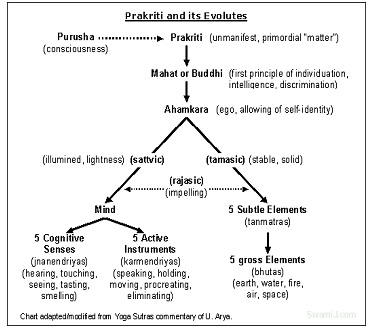
“ Prakriti and its evolutes”
(Reproduced from the diagram in http://swamij.com/prakriti-purusha-Sankhya.htm)
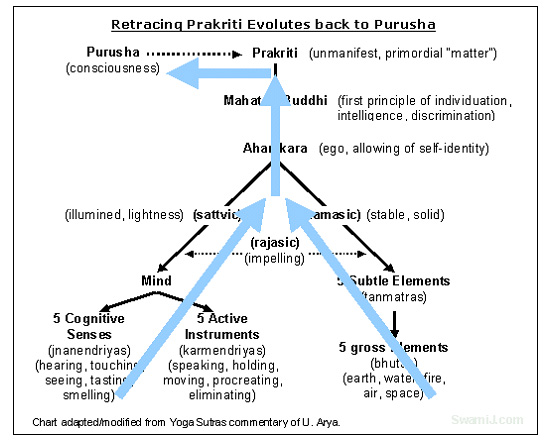
Refer to Evolutes of Unmanifest Matter
http://swamij.com/prakriti-purusha-Sankhya.htm
According to Sankya, the mind is one of the evolutes of Prakriti, but it plays a significant role in the process of the evolution of Prakriti. Recognizing the major role of the mind in the process of evolution, Patanjali makes use of mind and its activities for the counter movement of involution in the process of meditation. The attention of the mind is systematically used to encounter, examine and to transcend every level of the manifestation of reality for moving inward to the core of being, which is pure consciousness. (Y.S. 2/26-28,; 3/55-56)
Meditation starts with the concentration of the mind on the external world, with the awareness of the gross objects composed of five elements: space, air, fire, water, and earth. The mind then proceeds to explore the cognitive senses (jnanendriyas), active senses (karmendriyas) and then to mind (manas)itself, which is the source of the other
15 evolutes through the process of withdrawal (pratyahara). The process reaches the last stage when ego (ahamkara), which is an agent of attachment and aversion and which provides the individual self with false identities, is encountered. When the yogi transcends this I-ness (ahamkara), he transcends all levels of attachment and false identities and reaches the stage of Intelligence (Budhi).This is the stage where the individual consciousness is freed from the entanglement of the manifest world. But even Budhi is a construct or one of the evolutes of Prakriti. The goal of meditation is reached only when the individual self (atman) is completely separated from all relationship with Prakriti and comes to the realization of its reaching pure consciousness. This stage of the atman becoming completely separated from Prakriti to the self-realization of pure consciousness is called Kaivalya/Mukti in Sankya-Yoga.
Most of the Indian yogis superimpose the Vedanta metaphysics to Patanjali’s theory and practice of Yoga. The Sankya Yoga concept of Purusha is substituted by the Vedanta concept of Brahman, which is the one and only Reality. The individual soul (atma) and the world are illusory manifestations or superimpositions of Brahman and they are loosely called by the term Maya. In Sankya-Yoga, Maya is the power (sakti) of Purusha that infuses the Prakriti to evolve into the manifest world. In Vedanta, Maya is unreal and illusory in the order of Absolute Reality (Paramartikam satyam), but it is a relative reality in the order of the phenomenal reality (Vyavaharikam satyam) of the world. One has to transcend the phenomenal reality to reach the level of absolute reality in order to realize the unity and identity of atman and Brahman. This transcendental knowledge by which the individual soul attains the realization of the identity of jeevatma (individual soul) and Paramatma (Absolute Soul) through meditation is called Moksha (liberation) of the atma from Maya or Nirvana (merger) of the atma into Brahman, in Vedanta.
In fact, the subtle variations of the metaphysical concepts of reality in the Sankya-Yoga Vedanta schools do not matter as far as the use and goals of meditation are concerned. All these three physiological systems make use of meditation as a means to transecend the limiting adjuncts (upadhis) of the phenomenal world for attaining the realization of the indentity of the individual soul with Brahman/Purusha, the state of tranuility and peace of pure consciousness..
Mind, Self and Consciousness
As we have already seen, Patanjali’s Yoga is rooted in the rational theory of the working of the mind developed by Sankya. Like all the other Hindu philosophical systems, Sankya and Yoga are faithful to the teachings of Vedas and Upanishads.
Sankya-Yoga systems consider the mind as a whirlpool, where three elements (gunas) of Prakriti , viz., tamas, rajas and sattva are constantly in interaction, producing whirls of ripples and waves as in a disturbed pond. As mind (citta) is in a fluid or volatile state, it has no form of its own; it takes the shape of its container or its object and its movements are formed by its own whirls (vrittis) in its own confines. That is why citta vritti could be translated as ‘modifications and patterns of mind’ or ‘whirls/activities of mind‘. Peace and tranquility of mind can be achieved only when the whirls of mind are brought to stillness. According to Patanjali, these whirls of the mind can be brought under control by practice (abhyasa) and by exercise of dispassionateness (vairagya). Yoga is presented by Patanjali as an effective means of this control. He defines Yoga as the restraint exercised on the whirls of the mind. (Yogascitttavrittinirodha Y.S.1/2)
When we look inward to the activities of the mind we come into contact with the different states of our consciousness. Our inward journey passes, as the Mandukya Upanishad describes, through four states of consciousness, namely, the waking state (vaisvanara), dream state (taijasa), deep sleep (prajna) and the transcendental state (turiya). The whirl of mind (citta vritti) are at the maximum at the waking state and diminish in the successive states, reaching zero in turiya.. The fourth state (caturta) is the state of pure consciousness, the experience of the Ultimate Reality and truth. It is not experienced as an object in relation to a subject, but as the reality that underlies both subject and object and removes the distinction of subject and object., revealing the holistic nature of truth and reality. The Vedic sacred monosyllabic AUM (OM), otherwise known as Pranava combines all the four states of consciousness including the ineffable fourth (caturta) state which is voiceless, and represents the transcendental holistic reality of Brahman. Unlike ordinary sound, which is always produced by vibrations, AUM is said to be the sound without vibration ( anahata dhvani) and is the occult prnava mantra constantly and continuously repeated by Prakriti. This occult pranava mantra can be heard by the yogi during the practice of Yogic meditation.
According to Vedanta, the individual self and the Universal Self are identical. But, because of the influence of the limiting adjuncts (upadhis) such as, gross body, subtle body, external world, mental impressions (samskaras and vasanas) and finally, the whirls of mind (citta vritti) the individual self does not realize its identity. When the individual self is divested of all these upadhis through meditation, it reestablishes its identity with the Absolute Self. Yoga Sutras give specific instructions on controlling these upadhis through a progressive process of eight steps. Meditation comes in the last stages of this process, and citta vritti nirodha (restraint of whirls of mind) is only one of the steps in the astanga yoga.
The Eight Limbs (parts) of Yoga
The term Yoga (derived from the Sanskrit root, yuj) means ‘union’ It is used to indicate the process by which the individual soul is enabled to get united, or integrated, with the Universal Soul through meditation. Although Yoga has become very popular nowadays, as an effective way of achieving deep levels of relaxation and physical invigoration, the first and foremost goal of Yoga is to unleash the full human potential of the physical, ethical, emotional, mental, intellectual and spiritual dimensions. Yogic meditation is focused on the meditation of the Absolute, which is at the very heart of good yogic practice. The English word ‘meditation’ denotes what Maharshi Patanjali meant by samyama in his Yoga Sutas. Samyama is a combination of the last three stages, namely, dharana, dhyana and samadhi of the eight-fold path of Patanjali‘s Yoga Sutras forthe realization of pure consciousness. The Yoga system of Patanjali is called Astanga Yoga (Yoga with eight limbs/parts) because the whole process of Yoga has eight limbs or eight progressive steps towards the realization of the identity of the individual self with the Absolute Self. Before one reaches the final stages of meditation proper (samyama), one has to get integrated internally with one’s own total being in his social context, as a preparation for his final goal in Yoga; this is discussed in the second chapter of the book.
Patanjali’s Yoga Sutras contains 196 sutras, divided into four chapters. Chapter I deals with samadhi (awareness). The classical definition of Yoga is given in this chapter, as well as some of the obstacles. Chapter II deals with sadhana (practice) of Yoga and discusses the various obstacles to the practice of Yoga. The ethical code of yamas and niyamas is given in the first part, as well as the physical and mental preparation that would help concentration. Chapter III deals with vibhuti (supernormal power) of meditation. It speaks of the tripod of meditation, grouping dharana, dhyana and samadhi as a simultaneous practice of meditation under the name samyama. This can give to the yogi supernormal powers (vibhutis/sidhis), such as knowledge of the future, levitation, invisibility, clairvoyance, clairaudience etc. The last Chapter (IV) deals with Kaivalya (liberation) achieved through meditation, eliminating the samskaras/vasanas, the latent mental impressions of karmic origin. The chapter ends with the definition of Kaivalya, i.e., “kaivalya is that state in which gunas merge in their cause, having no longer a purpose in relation to purusha. The soul is established in its true nature (svarupa), which is pure consciousness.”(IV, 34)
Here is a summary of the astangas(eight limbs or parts) of Yoga:
1. Yamas. These are five restraining rules of conduct for the yogis.
a. Non-violence ((ahimsa)
b. Truthfulness (satyam)
c. Non-stealing (asteya)
d. Sex-abstinence (brahmacarya)
e. Non-covetousness (aparigraha)
2. Niyamas. These are five positive duties or laws of behavior for the yogis.
a. Cleanliness (sauca)
b. Contentment (santosa
c. Austerity (tapas)
d. Study of Scriptures (Svadhyaya)
e. Surrender to God (Isvara prnidhana)
(The next two limbs,Asanas and Pranayama form
the subdivision of Raja Yoga, known as Hatha Yoga)
3. Asanas These are the postures for meditation prescribed for the yogis.
4. Pranayama Regulation or control of breath.
5. Pratyahara Withdrawal of the senses in order to still the mind
6. Dharana Concentration of the mind that will lead to the next stage .
of meditation
7. Dhyana Meditation, state of pure thought and absorption,
not yet the final state
8. Samadhi Superconscious state of meditation, the deepest and
highest state of consciousness (The last three steps
constitute the internal practice of Raja Yoga)
Sadhana, The Practice of Yoga
Yamas and Niyamas
Yoga is primarily a praxis that enables man to get liberated from all kinds of attachment to the world, and the modifications of the self brought about by these attachments through meditation, so that it can reach the tranquil state of pure consciousness. As we have already seen, out of the eight steps (astangas) of Raja Yoga, the first five steps are preparations for the last three stages of meditation. Of the five preparatory steps, the first two are concerning the ethical behavior of the yogi in the society and in his personal life, while the other three are directly dealing with control of his body and bodily activities.
Patanjali begins the sadhana pada (the part on practice) of the Yoga Sutras, with a discussion on the five great obstacles (klesas) to the practice of Yoga, namely, avidya (ignorance), asmita (egoism), raga (attachment), dvesha (anger) and abhinivesa (will to live). A yogi has to eliminate these obstacles for the success of his practice of yoga. This is done step by step, by putting restraints on his social behavior through yamas and his personal inner behavior through niyamas, and by regulating the activities of his gross and subtle bodies through the practice of asanas, pranayama and pratyahara, in the light of the Vedic concepts of human physiology, psychology and cosmology.
The five ethical codes of restraint behavior (yamas) are ahimsa (non-violence), satya (truthfulness), asteya (non-stealing), brahmacarya (sex-abstinence) and aparigraha (non-covetousness). (YS II,30) The five positive inner behavior or personal duties (niyamas) are sauca (purity-physical and mental), santosha (contentment), tapas (austerity), svadhyaya (study of Scriptures) and iswara-pranidhana (surrender to God).(YS, II,31). Some of the other qualities that Patanjali suggests for the yogi are maitri (friendship and love), karuna (compassion), mudita (joy over others’ happiness) and upeksha (ignoring the defects of others). (YS. 1,33). These are universal virtues that the yogi should possess in order to deal with the living and nonliving things of this universe, all of them, the different manifestations of Brahman.
The three steps immediately preceding meditation, namely, yogic postures (asanas). breath-control (pranayama) and withdrawal of senses (pratyahara) heavily rely on the Vedic concepts of psychology and cosmology.
Human Physiology in Yoga
It would be useful to have a general idea of human physiology before we discuss the three preparatory steps, namely, asanas, pranayama and pratyahra of Patanjali‘s Raja Yoga. According to the Hindu Vedic traditions, the human body consists of matter and energy. The matter is the gross body and the energy (prana) is the source of life and action. The gross body grows through assimilation of nutrients and decomposes into elements on death. But each individual has a subtle body (susma sarira) and a causal body (karana sarira) that survive death. The gross body has seven energy centers (chakras), which provide energy to the whole body, making it alive and alert.
The chakras are subtle microcosmic archetypes without any strict physical location. But they are usually represented in a vertical axis with the base chakra, Muladhara, at the bottom, at the coccyx , at the bottom of spine and the crown chakra, Sahasrara, at the crown of the head. The other five chakras , between the base and crown chakras, are Svadisthana (near the navel), Manipuri (linked with the digestive system), Anahala (near the heart) and Ajna (at the center of the forehead).
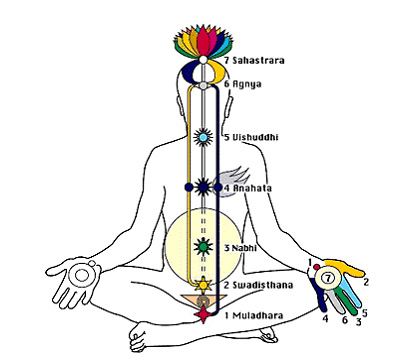
Diagram of the seven Cakras
These energy centers are connected by a network of 72,000 nadis, which are subtle tubular conduits through which the vital energy (prana) flows from one chakra to the other. The nadis should not be confused with blood vessels or nerve fibers; they are subtle bodies invisible to human eyes, just like the chakras, but their presence may be experienced by the yogis at advanced meditative stages. The nadis are divided into Sushumna, Ida and Pingala in accordance to their specific functions. Sushumna corresponds to the cerebrospinal and the central nervous system at mid-brain. It is the core nadi that runs vertically in the spine. Ida corresponds to the parasympathic nervous system, on the left side of Sushumna, and Pingala corresponds to the sympathetic nervous system on the right side. Each chakra functions as a storage battery and transducer; they also convert the pranic energy into conventional energy.
YOGA AND FUNCTIONAL PHYSIOLOGY
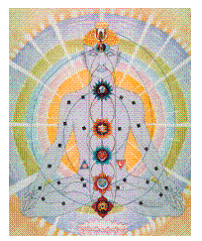
Moreover, according to the teachings of the Upanishads, in a human the self is at the core of the individual being and is well protected by five sheaths (panchakosas).
The five kosas are annamaya, pranamaya, manomaya, vijnanamaya and anandamaya. Each of these kosas has specific functions in taking care of the well being of the human individual.
Annamaya kosa (food sheath) is made up of the gross body sustained by nutrients and takes care of the physical and material needs of the individual. Pranamaya kosa (vital air sheath) is constituted of the five subtle organs of action and five pranas (prana, apana, vyana, udana and samana). Manomaya kosa (mental sheath) consists of the mind and the five subtle organs of perception. Vijnanamya kosa (intellectual sheath) consists of the intellect (budhi) and the ego (ahamkara). Anandamaya kosa (blissful sheath) is the causal body consisting of the latent energies, vasanas and impressions, existing in the dreamless sleeping state of pure consciousness (Please refer to the discussion on the different states of consciousness, "Mind, Self and Consciousness" on pp 6&7)
These sheaths are not concentric spheres, nor do they encase one another. They are subtle and so they pervade the whole body. There is no specific location for any of the sheaths. Each organ of the body, each tissue of the organ and each cell of the tissue contain all the five sheaths.
THE FIVE KOSAS, PROTECTING THE ATMAN
ASANAS:
It is important that the place of meditation and the time for meditation be conducive to inner peace and tranquility. The place and time should be free from external disturbance and distraction. A secluded room set aside for meditation is recommended. The auspicious time for meditation is brahama muhurtha, 4.00 to 6.00a.m., when Nature is in a most peaceful state. A person who meditates should be mentally and physically relaxed and comfortable. He may sit on a chair or on any comfortable seat if his seating helps concentrate on meditation. However, yoga recommends that a yogi sit upright on the floor with the head, neck and torso on a vertical line, perpendicular to the ground. The positioning of the legs and feet play a major role in most of the asanas. There are a number of ways one can position the legs and feet while sitting on the floor during meditation. Many yogic poses/postures (yogasanas) have come down to us from the ancient Hindu traditions. These asanas were used by the ancients for physical and mental health. Yoga system recommends some of them as useful postures for the different steps, such as pranayama, pratyahara and meditation of Astanga Yoga. Sidhasana, Padmasana, Svastikasana, Vajrsana and Sukhasana are five of these recommended asnas.
A brief description of these asanas is given below.
Sidhasana:
In this posture, both legs are bent at the knee, left heel left near the perineum resting against the right thigh, and the right heel over the left ankle keeping the right heel against the pubic bone. The arms are stretched in front, and placed on the respective knees with the palm facing upwards in cin-mudra (see the mudras).
Padmasana:
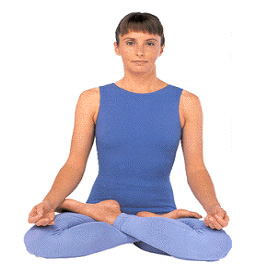
For padmasana one sits with both the legs bent at the knee, placing the right foot at the root of the left thigh with the heel near the navel, and the left foot at the root of the right thigh with the heel near the navel. The arms are stretched in front placing the back of the hand on the respective knee with the palm facing upwards.
Svastikasana:
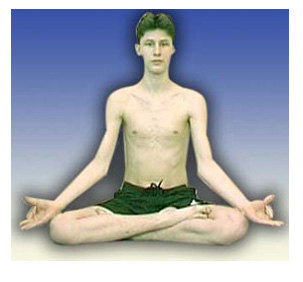
In svastikasana, the left foot is placed near the right thigh muscle, and the right foot is placed in the space between the left and right calf muscles. The hand is placed on the knees in jnana mudra or cin-mudra.
Vajrasana:

Vajrasana is practiced with the legs folded at the knees and the feet stretched backwards, and the big toes are crossed, keeping the knees together but the heels apart. The buttock is lowered and placed between the feet. The hands are placed on the respective knees with the palms facing downwards.
Sukhasana:
In Sukhasana the left foot is folded under the right thigh, the right foot under the left thigh, with the hands on the lap with the palms facing upwards and the right palm on the left (bhairava mudra). This is the easy meditation pose, ideal for beginners.
Savasana:
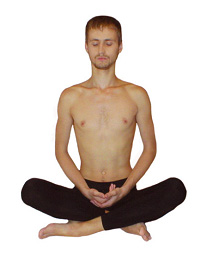
(This is not a meditation pose. But it is practiced after the pranayama session at the beginning of meditation) In this asana the yogi lies on his back without a pillow, with the hands a little away from the thigh and with the palm turned upwards. The heels are kept together, but the toes are apart.
For more details on ‘Asanas’ please refer to B.K.S Iyengar‘s, Light on Yoga (1997) New Delhi, HarperCollins
Mudras and Banda
The yogasanas are techniques that help the process of vitalizing the gross body and subtle body, the physical and mental powers of the individual through pranayama, through the intake, storing and circulation of the vital air (prana); they help also the process of the withdrawal of the senses from external objects (pratyahara) that facilitates concentration in meditation.
Mudra means a symbolic gesture. Mudras in yogic asanas symbolically evoke the inner mood of the yogi in a particular asana. They also facilitate the withdrawal of the senses from objects that distract one’s attention. Two mudras, usually used in asanas, helping respectively the pranayama and pratyahara are Jnana mudra and Cin-mudra.
Jnana and Cin-mudras:
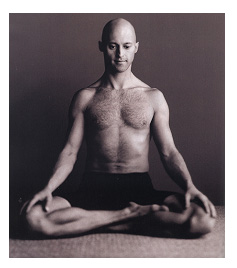
Cin-Mudra
Cin-Mudra is the psychic gesture of consiousness. It is performed the same way as the Jnana Mudra; the only difference is that the palms of both hands face upward while resting on the knees. In some pranayamas, which use the right hand to close and open the nostrils,only the left hand remains free for cin-Mudra.
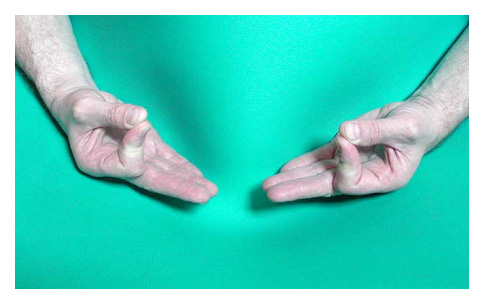
Bhairava/bhairavi-mudra:
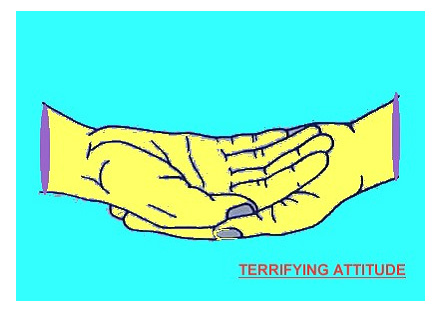
Bhairava/Bhairavi-mudrais keeping the hands on the lap, placing the dorsal right hand on the left palm (bhairava mudra), or the dorsal left hand on the right palm (bairavi mudra). Both palms face upwards in both the madras.
Banda is the contracting or tightening of the various parts of the body in the practice of yogic techniques. They also facilitate the circulation of different vital airs and the purification of the gross and subtle body of the yogi.
Three important bandhas are, mula bandha, uddiyani bandha, and jalandhara bandha. In mula bandha the muscles of the region of perineum are contracted and drawn upward. It facilitates the prana-apana vayu’s entrance into the susumna nadi. This bandha is used in the Sidhasana. Uddiyana bandha is practiced by emptying all the air from the lungs forcefully through the mouth and then contracting the abdominal muscles, drawing them upwards and back towards the spine; the muscles are slowly released, keeping the air outside as long a possible. This bandha can be practiced also in the standing posture.
Jaladhara bandha is practiced while the breath is retained in the lungs during the interval of inhalation and exhalation, by pressing the chin against the chest. This bandha is practiced in the sidhasana, padmasana and svastikasana. The bandhas are used with pranayama; they are also practiced without any connection with pranayama.
Pranayama
In the Hindu thought, which holds on to Vedic cosmology, prana is the cosmic vitalizing principle which is ever pervasive in the whole universe. From the scientific standpoint, prana may be considered the origin of fundamental forces and all forms of energies in the universe. No matter particle and no energy quanta can exist without motion. And no motion, no work, is possible without prana. At the atomic level, prana can be considered the energy that makes the electrons move in an atom. It is energy at its most fundamental level.
Prana as the subtle energy enters the human body either through or without a medium. It is convenient to collect prana through inhaling air, but it is possible to imbibe and assimilate prana without the medium of the inhaling air. Besides, prana constitutes the second sheath (kosa) of human being protecting the self by its intrinsic energies.
Pranayama is the process of controlling prana, and it is used in Yoga as a separate practice to help the yogi clear and cleanse the mind and body in preparation for meditation, and to help him in focusing the mind in the practice of asanas (yogic postures) maximizing the benefit of the practice. Prana is controlled by regulating the inhaling and exhaling of air. Air is a gross body, and it enters the human body through the gross bodies of the respiratory system, such as, nose, wind pipe and lungs. There are three stages in pranayama, namely, inhalation (puraka), exhalation (recaka) and retention (kumbaka). Pranayama can be practiced with retention of air (kumbaka sahita) or without the retention of air (kumbaka rahita).
The most commonly used forms of pranayama used in meditation are Ujjayi, Dirgha Pranayama and Nadi Sodhini. In the ujjayi the practitioner takes a long deep breath through the nostrils and contracts the back of the throat, creating a hissing sound and sending out the air in the same way. In the dirgha pranayama (complete or three part breathing), the practitioner uses diaphragmatic belly breathing, completely filling and emptying the lungs, and retaining the breath in between. In the nadi-sodhini (channel cleansing) the right hand is held up with the thumb near the right nostril and the ring finger on the side of the left nostril; the thumb and ring finger are used to open and close the respective nostrils for inhalation and exhalation.
Pranayama is not confined to the physical process of breath control, it is the collection of the vitalizing basic cosmic energy from the universe to be stored in the charkas, which channel it to the different parts of the body and transform it into conventional energies for making the human being alive and alert.
Pratyahara
Patanjali developed his Yoga system on the framework of Sankya’s concept and theory of mind. For Sankya, mind is an evolute of Ahamkara and Budhi, and it is the source of the evolution of the broader category of subtle bodies called antakaranas (internal instruments) and five organs of perception and five organs of action. The gross organs of perception and action are connected to the mind through the corresponding subtle organs. The subtle organs are regulated by the seven chakras. All the subtle entities related to the emprirical consciousness of the individual as a whole constiture the antakarana (internal instrument) that forms the apparaturs of the mind in order to help the mind to get in touch wiht and know and interact with the outside world. This micro apparatus of mind uses the brain and its related nervous system as its macro appraratus in order to relate itself to the world outside. Brain is thus the instrument of the mind. That is to say, mind and brain, according to Yoga are not identical; one is subtle and the other is gross.
External objects are perceived by the mind through the five subtle organs of perception,
vision, audition, olfaction, gustation, and sensation of touch (of pressure, pain, heat, etc.). Each subtle organ of perception has a corresponding gross organ(s), eyes, ears, nose, tongue and skin. The external stimuli are received by the gross sensory organs and transmitted to the respective brain centers through the nerves. The brain centers inform the antakaranas, which in turn direct the subtle organs to connect to the object with the mind. That is how the mind perceives the external objects. In pratyahara the five gross organs of perception, corresponding to the five subtle organs, are disconnected to each other as the subtle sensory organs are withdrawn to the citta by the yogi by concentrating on certain ideas, or on certain deliberately chosen sensations. In other words, all the subtle sensory organs are so completely absorbed in the mind that they cannot get out to perceive the external objects in spite of the external stimuli.
So the theory of pratyahara states that when the evolutes (five sense organs) are withdrawn to the evolvent,(’egoity’ or ahamkara), the subtle organs cannot reach the source of the external stimuli of the object,t and thus sense perception is blocked. In practice, however, many gurus recommend a gradual withdrawal of senses rather than a total withdrawal of all the senses at the same time, especially for the beginners. They recommend that the beginner start with intense concentration on the activity of one sense, namely, the olfactory, visual or auditory sense, that would keep the other senses withdrawn. For example, i) concentrate on the aroma of a perfumed meditation room, ii) concentrate on a visual object in trataka mudra (i.e., gazing on a point or spot like a dot drawn on a white paper with black ink, on the tip of a burning flame of a candle or a lamp, an AUM symbol, a crystal, or in advanced stages on an internal chakra with closed eyes) or iii) concentrate on a low-pitched sound in harmony, on ‘aum’ mantra (repetition of ‘aum‘) or any devotional hymn. Use of mantra japa (recitation of short prayers), vocal or mental , is also considered to be an effective means of pratyahara.
Dharana , Dhyana and Samadhi (Samyama)
Dharana, dhyana and samadhi are the last three steps (angas) of the Astanga Yoga of Patanjali; all three together are called samyama. Each of these three steps is, and all of them together are denoted by the English word meditation, although they differ from one another as far as the goals of yoga is concerned. In all the three stages of meditation, the meditator sits in one of the meditative asanas, i. e., in sidhasana, padmasana, svastikasana or sukhasana on a firm floor or ground. It is important that he sits in a vertically upright position with the head, neck and torso perpendicular to the ground and in cin-mudra or in jnana mudra, and if in sukhasana, in bhairava mudra.
Dharana is a higher stage of concentration of the mind beyond pratyahara. The first stage of dharana coincides with the final stages of pratyahara. The beginner of meditation starts with concentrating on a particular spot through the practice of trataka (see ‘pratyahara‘). In the second stage, the concentration is on some position on the external body of the meditator, for example, at the tip of the nose or at the eyebrow center, etc. At the third stage, the eyes are closed and the attention is focused on some internal position in the body. Usually the meditator concentrates on his eyebrow center (ajna cakra).
Dhyana is the focusing of mind’s attention on a single idea, which flows in the mind uninterruptedly as a continuous stream. For example, one can meditate on the elements of the universe, earth, water, air, fire and space in succession for two or three minutes. Or one may meditate on certain forms of religious symbols, like cross, aum, or pictures like that of Jesus, the Budha, Krishna, etc., or on a chakra, if he is an advanced practitioner of dhyana. During dhyana, silent mental recitation of mantras (short prayers), concentrating on their meaning, is recommended.
Samadhi is different from dhyana because in dhyana the meditator is actively involved in following the flow of the idea in the mind, while in samadhi the meditator is in a thoughtless state. Only a person who has reached the stage of maturity in meditation can stay in this thoughtless state of meditation for a while, as one is always liable to be intruded by extraneous thoughts. In such situations the meditator gets the help of an alamba (support), a mantra-japa, that will take him to alamba-dhyana for a while. Samadhi is resumed when the mind moves back to the thoughtless state. During samadhi, alamba-dhyana is repeated as and when it becomes necessary.
The yogic process of samyama (meditation) can be summarized as follows:
The meditator sits in one of the meditative postures (yogasanas) in a vertically erect position, with closed eyes and relaxed body and mind, as described above (in para.2 of the subheading, ‘dharana, dhyanan and samadhi’) and visualizes the image of his/her spiritual ideal (ista devata) at the eyebrow center. Mantra japa, a short prayer in less than sixteen syllables, addressed to the ista devata is recited mentally for a few minutes. Then the visualization and mantra japa are dropped and the japa in one syllable, preferably aum is continued as alamba (support).
Up to this point the meditator is in the dharana-dhyana stage. Here he suspends the recitation of alamba and the mental activity to plunge into samadhi, and remains in a thoughtless condition. If and when any distracting thought comes into the mind, he takes recourse in the mental japa of alamba.. When the situation is over, once again he plunges into samadhi and remains there as long as possible. When the meditation is over, he sits relaxed for a while and ends the meditation. The samadhi state is the turiya state, the culmination of yoga.
If one meditates at least twice a day, the mind will be peaceful, as it gets free from all disturbances and agitations. In meditation that culminates in samadh, budhi is completely absorbed in purusha or the individual self (according to Patanjali) or in the Great Self (according to Vedanta). The total absorption of budhi in the Self will enable the yogi to listen to the low pitched harmonious synchronous humming sound of prnava aum. Hearing of this sound is considered to be an index of the maturation of yogic practice. It is the traditional Hindu belief that every created entity in Nature continuously repeats the anahata dvani (non-vibrant sound), the pranava ‘aum‘; and the yogis believe that this pranava mantra becomes audible to the yogis in the full state of pratyahara and samadhi. The yogi, in samadhi, intently fixing his budhi on the Self and by the complete absorption of the budhi in the self, keeps his mind motionless as a flame without flicker in a windless place. This state of the yogi, with his budhi completely anchored in God is called sthitaprajna. Once this state has been attained, the yogi’s life is believed to be filled with peace.
The ultimate goal of yogic meditation is the attainment of self-realization or enlightenment. However, the yoga practices of asana, pranayama, pratyahara and samyama (meditation), while helping the yogi attain self-realization, brings about a holistic coordination of the body, mind and spirit in the yogi that makes him physically fit, psychologically balanced and mentally at peace with himself, with others and with the world. These side effects of yogic meditation are the chief benefits for which yoga has been sought after by the modern man, especially in Europe and America, because of his need for peace and relaxation in a fast-paced life. However, many of the yoga meditation centers focus only on these secondary benefits of yoga. They emphasize also the healing effect of meditation (through the control of mind), and on curing diseases that are psychosomatic. Indeed, many stress-related disorders are cured by the practice of meditation. It is also acknowledged by practitioners and others that yoga practices give a holistic, healthy, creative and peaceful daily life. All these benefits make the practice of yoga that much more worthwhile, even apart from its most important, objective aspect of ‘leading the self from the unreal to the real, from darkness to light and from death to immortality’
Fr. Thomas Vempala CMI
St. Joseph’s Catholic Church
405 N. Convent St
Stanton, Texas 79782-0846
BIBLIOGRAPHY:
1) Iyengar, B.K.S., 1997. Light on Yoga, Harper-Collins, New Delhi.
2) Panda, N.C., 2003, Meditation, Science and Practice, D.K. Print world(P)Ltd, New Delhi
3) Radhakrishnan, S., 1969, The Principal Upanishads, George Allen & NnWin, London
4) Sinha, N., 1979, The Sankya Philosophy, Oriental Books, New Delhi
5) Wood, J.H., 1983, The Yoga System of Patanjali, Motilal Banarsidass, Delhi
6) <http://www.lovechristopher.com/graphics/siddhasana1.jpg>
7) <http://www.sivananda.org/teachings/asana/images/padmasana.gif>
8) http://www.rassvet.org/images/svastikasana.jpg
9) http://www.smruthi.yoga.20m.com/images/vajrasana.jpg
10) http://natas.h11.ru/p_Sukhasana.jpg
11) <http://www.yoga-stuttgart.de/fileadmin/images/yogabilderr/1.01_SAVASANA.jpg>
12) <http://www.olinebangalore.com/images/heal/yoga/cinmudra.jpg>